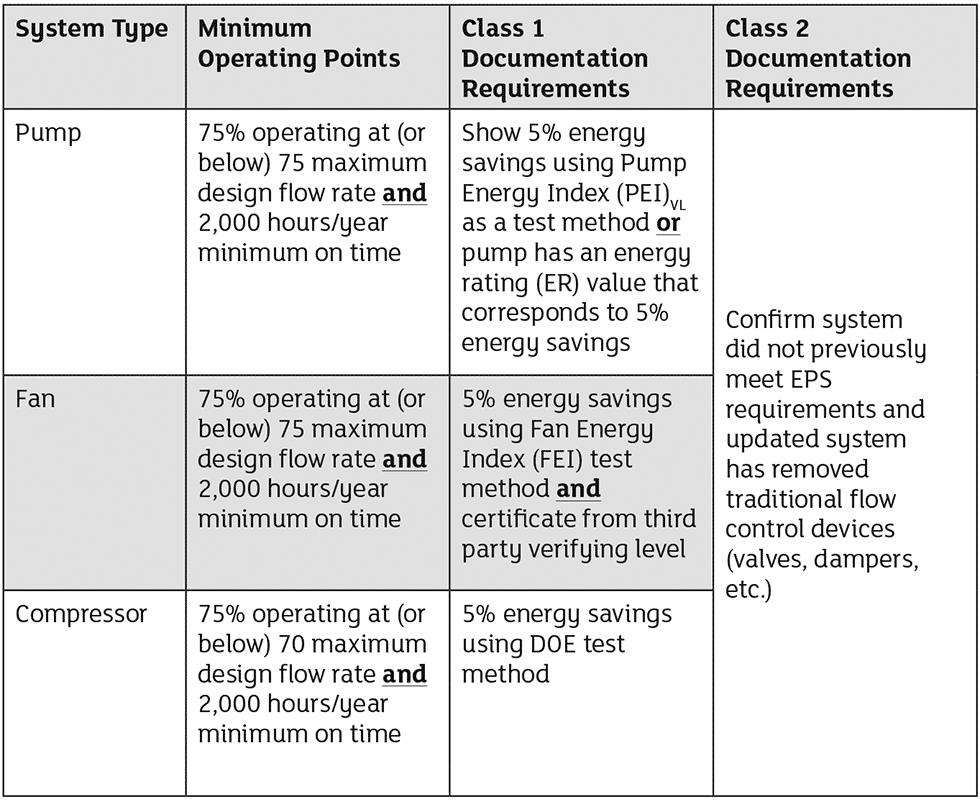
Who isn’t interested in free money? What if users could get reimbursed for new equipment and upgrades they already made to their facilities from the government?
Well, there is good news. If they purchased a new pump, fan or compressor system, or upgraded an existing system between Jan. 1, 2021, and Sept. 30, 2023, their facility might be eligible for thousands of dollars in rebates through the recently initiated Expanded Products System (EPS) rebate program. This program is being administered through the Department of Energy’s (DOE’s) newly created Office of Manufacturing and Energy Supply Chains (MESC). Despite some challenges, which are to be expected for a first-time government program of this nature, the program offers a glimpse of how the DOE plans to incentivize end users to install equipment exceeding federal minimums.
Background & Timing
The EPS rebate program was one of nearly 500 programs authorized under the Infrastructure Investment and Jobs Act (IIJA), which was passed in November of 2021. Through this program, Congress set aside $10 million in funds to provide rebates for purchases of qualified new high efficiency pump, fan or compressor systems. The program also included previously installed systems that were upgraded with advanced electronic controls as eligible to receive rebates under this program.
Class 1 products cover new installations of certain types of pumps, fans and compressors that meet or exceed the federal minimums by at least 5% and were installed between Oct. 1, 2021, and Sept. 30, 2023 (which align with the government’s fiscal years of 2021 and 2022).
Class 2 products are defined as pumps, fans or compressor systems that have been retrofitted to bypass traditional mechanical dampers and valves and instead rely on a motor and drive to control flow rates. The eligibility window for these products differs from Class 1 products, covering upgrade dates between Jan. 1, 2021, and Dec. 31, 2022.
While the installation window is unfortunately short, money for the rebates will extend until funds are exhausted. Facilities that have not yet submitted rebate applications still have a good chance to receive funds for qualified upgrades.
What Are the Requirements for an Eligible System?
To qualify, a facility must have installed at least one qualified system specified in the program that was added into service during the applicable eligibility period.
To be considered for a potential rebate, all systems must have electronic controls that include the following capabilities:
Capable of variable or multispeed operation – Modern controls can be either variable or multispeed. Variable speed controls allow more precise matching of the motor speed to the demand load, while multispeed controls, having predefined setpoints (e.g., 25%, 50%, 75%, 100%), are often easier to set up and are generally lower cost.
Partial load control to reduce input power – The electronic control needs to have the ability to reduce motor torque, which helps reduce power requirements.
Rated 1 horsepower (hp) or higher – A 1 hp or higher threshold aligns with most of the end-use product regulations and represents the greatest energy savings opportunity.
Automatically adjust speed using sensors – Many newer drives have the capability to use information from sensors within the system to adjust speed. To qualify as an eligible EPS, the overall system must be configured to take advantage of this and not be wholly reliant on user input to adjust motor speed/flow rates.
All systems must meet several minimum operating requirements. Verifying these parameters helps ensure the target systems receiving the incentives generate the most energy savings.

IMAGE 1: Summary of DOE/MESC guidance. (Image courtesy of Nidec Motor Corporation)
Class 1 products require documentation showing the system exceeds current minimum federal requirements for efficiency. Importantly, this is different than demonstrating the new system is more efficient than the previous installation. Rebates are only available for systems that exceed the current federal minimums when tested in prescribed ways.
The only requirement for Class 2 systems (beyond the drive capabilities and minimum operating times) is that mechanical valves and similar hardware need to be bypassed. The guidance does not provide clarity on valves required for safety, but such systems will likely be allowed, provided they are not also used for flow control.
A summary of the different operating conditions for each major system type (pump, fan or compressor), along with documentation differences, is found in Table 1.
Registration & Submitting an Application
If a facility has systems that potentially qualify for the rebates, the next step is to identify a point-of-contact (POC), gather documentation materials and register the facility. The process is simple and captures general information about the facility similar to other government websites, such as sam.gov. One recommendation is to obtain a Unique Entity Identifier (UEI) prior to starting the registration process. While not required, having a UEI will generally result in a quick validation process.
After the program administrator reviews the application, the POC will be provided additional instructions on submitting a formal application. Since each system is reviewed individually, organizations with multiple systems will need to prepare separate applications for each system. The cap of $25,000 is based on a per-facility, pre-year limit. This means companies could receive hundreds of thousands in rebates if several facilities were built or company-wide upgrades were implemented across multiple sites, especially if those upgrades happened over multiple years.
Future Programs by the DOE?
The EPS rebate is the first known program that is focused on incentivizing variable speed drives at the federal level. The wording adopted in the bill effectively resulted in a retroactive rebate program. Because of this, the number of facilities that can take advantage of the program will be much smaller than if new installations in 2024 and beyond were covered.
However, it does give a glimpse of how MESC plans on implementing programs, and if future programs are authorized by Congress, they are likely to follow the same pattern of documentation to demonstrate replacement systems result in meaningful energy savings while also exceeding federal minimums.

